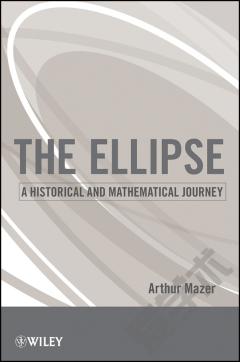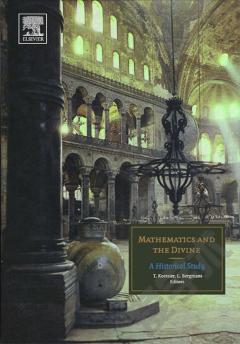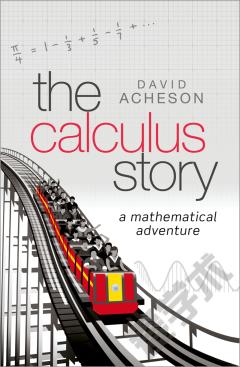The Ellipse —— A Historical and Mathematical Journey
----- 椭圆:历史与数学之旅
PREFACE. CHAPTER 1: INTRODUCTION. CHAPTER 2: THE TRAIL: STARTING OUT. 2.1 A Sticky Matter. 2.2 Numbers. 2.2.1 Integers, Rational Numbers, and Irrational Numbers. 2.2.2 The Size of the Irrational Numbers. 2.2.3 Suitability of Rationals and the Decimal System. 2.2.4 Rational and Irrational Outcomes. CHAPTER 3: THE SPACE: GEOMETRY. 3.1 Euclidean Space, Dimension and Rescaling. 3.1.1 Euclidean Space and Objects. 3.1.2 Euclidean Space in Higher Dimensions. 3.1.3 Unit Measurements and Measures of Objects. 3.1.4 Rescaling, Measurement, and Dimension. 3.1.5 Koch's Snowflake, a Fractal Object. 3.2 Measurements of Various Objects. 3.2.1 Pythagorean Theorem, Length of the Hypotenuse. 3.2.2 Cavalieri's Theorem in Two Dimensions. 3.2.3 Cavalieri's Theorem, Archimedes Weighs In. 3.2.4 Simple Applications of Cavalieri s Theorem. 3.2.5 The Circle. 3.2.6 Surface Area of the Cone. 3.2.7 Cavalieri's Theorem a Stronger Version in Three Dimensions. 3.2.8 Generalized Pyramids. 3.2.9 The Sphere as a Generalized Pyramid. 3.2.10 The Surface Area and Volume of the Sphere. 3.2.11 Equal-Area Maps, Another Excursion. CHAPTER 4: THE LANGUAGE: ALGEBRA. 4.1 Cartesian Coordinates and Translation of the Axes. 4.1.1 Intersections of Geometric Objects as Solutions to Equations. 4.1.2 Translation of Axis and Object. 4.2 Polynomials. 4.2.1 Lines. 4.2.2 Parabolas and the Quadratic Equation. 4.3 Circles. 4.3.1 Equations for a Circle. 4.3.2 Archimedes and the Value of . 4.3.3 Tangent Lines to a Circle. 4.4 The Four-Dimensional Sphere. 4.4.1 Pythagorean Theorem in Higher Dimensions. 4.4.2 Measurements in Higher Dimensions and n-Dimensional Cubes. 4.4.3 Cavalieri's Theorem. 4.4.4 Pyramids. 4.4.5 The n-Dimensional Sphere as an n-Dimensional Pyramid 4.4.6 The Three-Dimensional Volume of the Four-Dimensional Sphere's Surface 4.5 Finite Series and Induction. 4.5.1 A Simple Sum. 4.5.2 Induction. 4.5.3 Using Induction as a Solution Method. 4.6 Linear Algebra in Two Dimensions. 4.6.1 Vectors. 4.6.2 The Span of Vectors. 4.6.3 Linear Transformations of the Plane Onto Itself. 4.6.4 The Inverse of a Linear Transformation. 4.6.5 The Determinant. 4.7 The Ellipse. 4.7.1 The Ellipse as a Linear Transformation of a Circle. 4.7.2 The Equation of an Ellipse. 4.7.3 An Excursion into the Foci of an Ellipse. CHAPTER 5: THE UNIVERSAL TOOL: TRIGONOMETRY. 5.1 Trigonometric Functions. 5.1.1 Basic Definitions. 5.1.2 Triangles. 5.1.3 Examples. 5.2 Graphs of the Sine, Cosine, and Tangent Functions. 5.3 Rotations. 5.4 Identities. 5.4.1 Pythagorean Identity. 5.4.2 Negative of an Angle. 5.4.3 Tan( ) in Terms of Sin( ) and Cos( ). 5.4.4 Sines and Cosines of Sums of Angles. 5.4.5 Difference Formulas. 5.4.6 Double-Angle Formulas. 5.4.7 Half-Angle Formulas. 5.5 Lucky 72. 5.6 Ptolemy and Aristarchus. 5.6.1 Construction of Ptolemy's Table. 5.6.2 Remake of Aristarchus. 5.7 Drawing a Pentagon. 5.8 Polar Coordinates. 5.9 The Determinant. CHAPTER 6: THE SLAYER: CALCULUS. 6.1 Studies of Motion and the Fundamental Theorem of Calculus. 6.1.1 Constant Velocity and Two Problems of Motion. 6.1.2 Differential Calculus, Generalizing the First Problem. 6.1.3 Integral Calculus, Generalizing the Second Problem. 6.1.4 Relations Between Differentiation and Integration and the Fundamental Theorem of Calculus. 6.1.5 Integration, Leibniz Notation, and the Fundamental Theorem of Calculus. 6.2 More Motion: Going in Circles. 6.3 More Differential Calculus. 6.3.1 Differentiation Rules. 6.3.2 Notation and the Derivative at a Specified Point. 6.3.3 Higher Order Differentiation and Examples. 6.3.4 Differentiation and the Enquirer. 6.4 More Integral Calculus. 6.4.1 The Antiderivative and the Fundamental Theorem of Calculus. 6.4.2 Methods of Integration. 6.5 Potpourri. 6.5.1 Cavalieri's Theorem and the Fundamental Theorem of Calculus. 6.5.2 Volume of the Sphere and Other Objects with Known Cross-Sectional Areas. CHAPTER 7: EIGHT MINUTES THAT CHANGED HISTORY. 7.1 Newton's Laws of Motion. 7.2 Galilean Checkpoint. 7.3 Constants of Motion and Energy. 7.3.1 Energy of a Tossed Object. 7.3.2 Energy of a System Moving in a Single Dimension. 7.4 Kepler and Newton: Aristarchus Redeemed. 7.4.1 Polar Coordinates. 7.4.2 Angular Momentum. 7.4.3 The Ellipse. EPILOGUE. BIBLIOGRAPHY. INDEX.
{{comment.content}}








 京公网安备 11010802027623号
京公网安备 11010802027623号